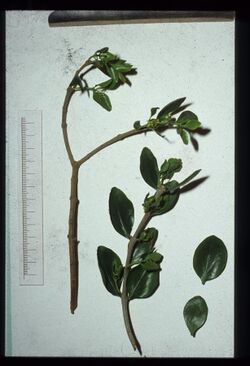Biology:Tupeia
| Tupeia | |
|---|---|

| |
| Tupeia antarctica | |

| |
| Tupeia antarctica | |
| Scientific classification | |
| Kingdom: | Plantae |
| Clade: | Tracheophytes |
| Clade: | Angiosperms |
| Clade: | Eudicots |
| Order: | Santalales |
| Family: | Loranthaceae |
| Genus: | Tupeia Cham. & Schltdl.[3][4] |
| Species: | T. antarctica
|
| Binomial name | |
| Tupeia antarctica (G.Forst.) Cham. & Schltdl.[2]
| |
Tupeia is a monotypic genus of semi-parasitic shrubs (mistletoes) which occurs in both the North and South Islands of New Zealand.[2] There is only one species in the genus: Tupeia antarctica.[2] There are no synonyms.[2]
Species
- Tupeia antarctica (G.Forst.) Cham. & Schltdl.[2]
Description
The species, Tupeia antarctica (common names - taapia, pirita, white mistletoe, tupia), is a dioecious[5] mistletoe which grows up to 1 m wide. Its bark is white, and the twigs are finely hairy. The leaves are variously shaped, fleshy, bright green and from 10 to 70 mm long. The flowers are tiny and the fruit is white to pinkish.[6]
Habitat
It is found in forest or scrub, on a wide range of hosts including tarata (Pittosporum eugenioides), karo (Pittosporum crassifolium), Coprosma species, putaputaweta (Carpodetus serratus), fivefinger (Pseudopanax arboreus), white maire (Nestegis lanceolata) and broom.[6] According to De Lange et al., Tupeia antarctica parasitises some 48 hosts (11 exotic) with the most common host families being Fabaceae and Rubiaceae.[5]
Etymology
The genus is named for Tupaia (c. 1725 – 1770), a Tahitian navigator and priest.[6] The specific epithet, antarctica, derives from the Latin word, anti, meaning "against" or "opposite" and the Greek word, arktos, meaning "bear", giving an adjective, antarctica, which meant opposite the constellations of the Ursus Major and Ursus Minor, "opposing the north", or "Antarctic".[7]
Taxonomy
Tupeia antarctica was originally described by G.Forst. in 1786 as Viscum antarcticum,[8][9] but the genus was revised to Tupeia in 1828 by Chamisso and Schlechtendal.[2]
Status
Tupeia antarctica is classified (2018) as having an "At Risk - Declining" conservation status under the New Zealand Threat Classification System, (its predicted decline from greater than 100 000 individuals being from 10 to 70%).[1] A 2002 study[10] discusses the threat from possum browsing which is preventing the recruitment of new individuals.
References
- ↑ 1.0 1.1 Lange, Peter J. de; Rolfe, Jeremy R.; Barkla, John W.; Courtney, Shannel P.; Champion, Paul D.; Perrie, Leon R.; Beadel, Sarah M.; Ford, Kerry A. et al. (2018-05-01). "Conservation status of New Zealand indigenous vascular plants, 2017". New Zealand Threat Classification Series 22: 37. OCLC 1041649797. https://www.doc.govt.nz/globalassets/documents/science-and-technical/nztcs22entire.pdf.
- ↑ 2.0 2.1 2.2 2.3 2.4 2.5 "Tupeia Cham. & Schltdl. | Plants of the World Online | Kew Science". http://powo.science.kew.org/taxon/urn:lsid:ipni.org:names:25369-1.
- ↑ "Tupeia". Australian Plant Name Index (APNI), IBIS database. Centre for Plant Biodiversity Research, Australian Government. https://biodiversity.org.au/nsl/services/rest/name/apni/147609.
- ↑ Chamisso, L.K.A. von & Schlechtendal, D.F.L. von (1828) Linnaea: ein Journal für die Botanik in ihrem ganzen Umfange, oder Beiträge zur Pflanzenkunde 3: 203
- ↑ 5.0 5.1 de Lange, P.J.; Norton, D.A.; Molloy, B.P.J. (1995). "An annotated checklist of New Zealand mistletoe (Loranthaceae) hosts". New Zealand's Loranthaceous Mistletoes: 87. https://www.researchgate.net/publication/234131027.
- ↑ 6.0 6.1 6.2 "Tupeia antarctica | New Zealand Plant Conservation Network". http://nzpcn.org.nz/flora_details.aspx?ID=210.
- ↑ "antarcticus,-a,-um". http://www.plantillustrations.org/epithet.php?id_epithet=214961%3C/div%3E%3Cdiv%20class=.
- ↑ "Tupeia antarctica (G.Forst.) Cham. & Schltdl. | Plants of the World Online | Kew Science". http://powo.science.kew.org/taxon/urn:lsid:ipni.org:names:552237-1.
- ↑ Forster, G. (1786). "Fl. Ins. Austr.". p. 70. https://biodiversitylibrary.org/page/11162976.
- ↑ Sweetapple, P. J., et al. Sweetapple, P. J.; Nugent, G.; Whitford, J.; Knightbridge, P. I. (2002). "Mistletoe (Tupeia Antarctica) Recovery and Decline Following Possum Control in a New Zealand Forest". New Zealand Journal of Ecology 26 (1): 61–71. pdf
External links
- Tupeia antarctica: Images and occurrence data from GBIF
- Tupeia antarctica: Images and more complete description from NZPCN
Wikidata ☰ Q10385479 entry
 |


